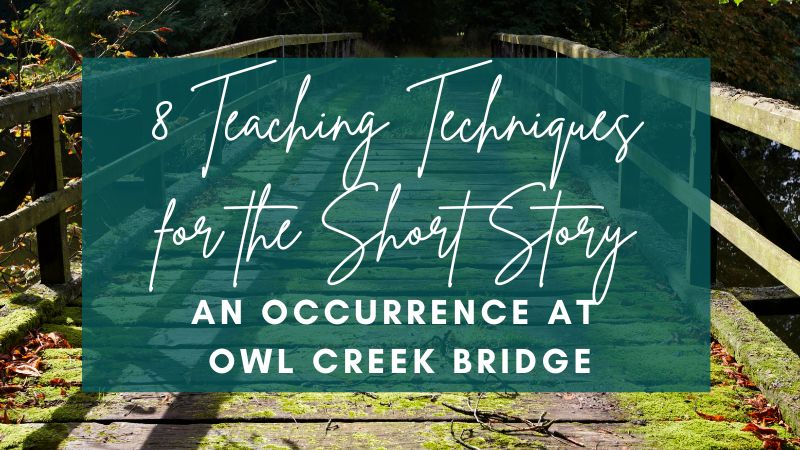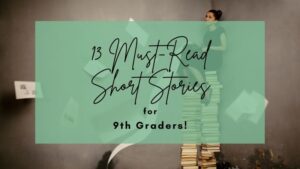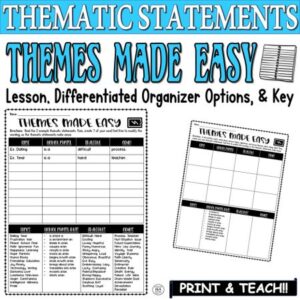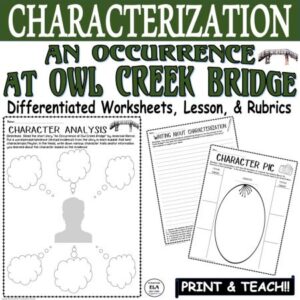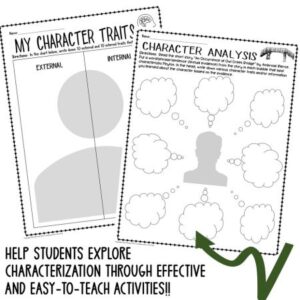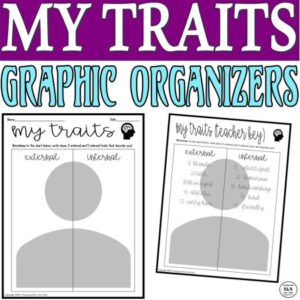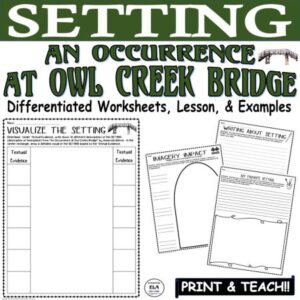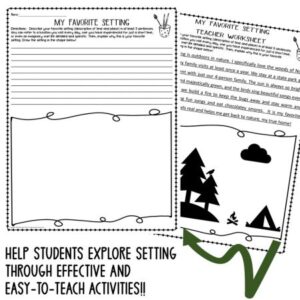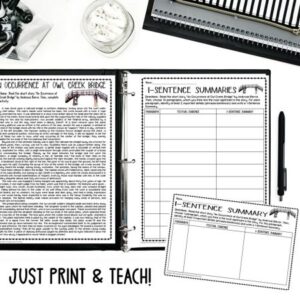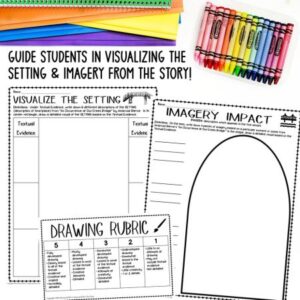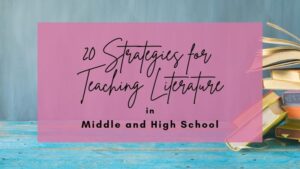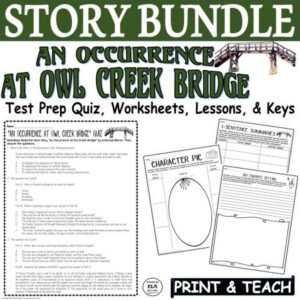If you desire to up your game by teaching higher-level short stories, check out Ambrose Bierce’s “An Occurrence at Owl Creek Bridge” (also known as “An Occurrence at Owl Bridge”)! A perfect addition to any American Literature class, Civil War lesson, or short story unit, this story tells the realistic tale of a soldier who experiences both dream and delusion during the war involving the North versus the South.
It will most likely take several days to truly teach the major ideas within the story; however, the reading of the short story alone takes around 30 minutes. There are even several wonderful versions available online!
Keep reading below for 8 Teaching Techniques for An Occurrence at Owl Bridge Short Story!
Need help with Reading Test Prep? Check out this FREE Pack of 3 Test Prep Activities to help students achieve success on standardized tests!

8 Teaching Techniques for An Occurrence at Owl Bridge Short Story
1. Teach Vocabulary
I won’t sugarcoat it for you. An Occurrence at Owl Bridge is full of vocabulary that might challenge the average college student’s own lexicon. But trust me; your students will enjoy the plot and characters. Bierce describes each with such specificity and creativity that even if not every word is understood, it will be completely okay. They’ll get it with a little bit of help.
In my graduate program, I read many a literary paper or text I could not fully grasp without notes, annotations, research, etc. The struggle is a part of how we grow, and providing students access to some of the more complex vocabulary words before reading the short story will help!
Here are some words that you might want to focus on before you read An Occurrence at Owl Bridge by Ambrose Bierce:
- stockade
- embrasure
- adorn
- subordinates
- sluggish
- Yanks
- apprehension
- civilian
- conscious
- delirium
Before beginning the story, students could pick words they don’t know to research, visualize, and analyze OR you could offer specific words to examine in small groups, pairs, or individually!
If you need more ideas for teaching short stories, click below!
2. Teach Theme
What is a Theme?
The theme is simply the message (or messages) the author and/or creator desires to convey. This message (theme) should require more than one or two words. We really don’t want a single phrase.
What we want from students is an ENTIRE SENTENCE when teaching about a story’s theme!
There could also be multiple themes in a short story, and students need to know that there really is no perfectly crafted theme. Well, this statement is true unless the author tells us otherwise…
HOW TO DETERMINE THEME:
- Determine the major topics in An Occurrence at Owl Bridge. What are the main subjects of the text? (Ex. dreams, illusions, war, soldiers, relationships, bravery, heroism, etc.)
- Identify what the author is trying to say about the topic. What message is he/she trying to get across to the reader or general audience?
- Write a theme in 1 sentence. How can I get a theme across in 1 complete sentence?
I know that this step-by-step process sounds super simple, but I also recognize that teaching students how to identify and write a thematic statement is tough in the real world!
Take your time, and let students come up with 1 sentence themes about movies and/or stories they are already familiar with! You could even do a whole group guessing game for themes in movies, and students will be required to guess which movie fits the provided themes!
Check out this THEMES MADE EASY pack to help with the process of teaching theme in An Occurrence at Owl Bridge!
3. Teach Characterization
At first glance, characterization analysis seems like something middle and high school students should have mastered in elementary school; however, the more difficult the text, the more difficult the process of discerning a character’s true traits becomes.
We can examine characterization through the narrative’s description, dialogue, and the characters’ actions/interactions. Taking each element into account is vital in a story like An Occurrence at Owl Bridge!
You will first want to teach the types of characterization. Be sure to teach the definitions with examples.
2 Types of Characterization:
- Direct Characterization-We as readers are DIRECTLY told about a character’s traits, usually through narration.
- Indirect Characterization-Readers need to infer a character’s traits based on INDIRECT means like dialogue or interactions.
For example, at the beginning of An Occurrence at Owl Bridge, we are DIRECTLY told about the protagonist’s situation. We know through this excerpt that the man has been captured and is currently in Alabama awaiting his own hanging. BUT we don’t know WHY he is in this situation. We cannot infer any INDIRECT character traits based on the below passage.
A man stood upon a railroad bridge in northern Alabama, looking down into the swift water twenty feet below. The man’s hands were behind his back, the wrists bound with a cord. A rope closely encircled his neck. It was attached to a stout cross-timber above his head and the slack fell to the level of his knees.
Similarly, we are given DIRECT traits in this other excerpt as well. The speaker is making inferences about the man being “no vulgar assassin,” but he also relates physical traits as well.
The man who was engaged in being hanged was apparently about thirty-five years of age. He was a civilian, if one might judge from his habit, which was that of a planter. His features were good—a straight nose, firm mouth, broad forehead, from which his long, dark hair was combed straight back, falling behind his ears to the collar of his well fitting frock coat. He wore a moustache and pointed beard, but no whiskers; his eyes were large and dark gray, and had a kindly expression which one would hardly have expected in one whose neck was in the hemp. Evidently this was no vulgar assassin.
Focusing on characterization as you read An Occurrence at Owl Bridge with your students will be helpful in comprehending the most important parts of the story!
You could also focus on INTERNAL and EXTERNAL character traits. Check out this FREE PACK to make introducing characterization a bit easier!
4. Teach Setting
Setting is the description of time and place. Oddly enough, identifying the elements of the setting and their impact can be tough to teach. When it comes to watching movies, the setting is MUCH easier to analyze.
Through the visuals and sounds/music, the viewer can quickly recognize the intended purpose of the setting.
At the beginning of An Occurrence at Owl Bridge, the setting depicts a man on a bridge awaiting his fate. The description of the setting is significant as it directly connects to the title and meaning of the short story.
To get students more engaged, teach the concept of setting directly by citing evidence. Students can pick 3, 5, 7, or even 10 pieces of evidence describing a scene from the story. Then, they can draw the setting based on the evidence!
Having a gallery walk to showcase these visuals would make the experience even more interactive!
Click below for ready-made setting activities for An Occurrence at Owl Bridge!
5. Teach Summarizing
Ultimately, I am a big believer that students need to read A LOT to become successful readers. Go figure, right?
A part of reading successfully is the ability to summarize what one has read.
Ask your students these questions:
- What is the main topic/subject of the text?
- How is each paragraph connected/similar?
- What is the central idea of a paragraph, chunk, or page?
- What is the central idea of the whole text?
- What evidence supports the central idea?
- What is the BEST evidence to support the central idea from different parts of the text?
Click below for ready-to-use summary activities to make teaching An Occurrence at Owl Bridge STRESS-FREE!
6. Teach Imagery
There are so many ways we can attack the literary devices in this story. You can analyze similes, personification, hyperbole, etc.
My favorite literary device to examine in An Occurrence at Owl Bridge is imagery!
Imagery is the description with a focus on the five senses: sight, sound, touch, taste, and smell.
Too often, students ONLY focus on visualization/sight. I get it. An image is easier to identify at times.
So we really need to help students expand their repertoire as they examine higher-level passages!
Here is a simple and easy process for teaching imagery to any secondary student:
- Define the term.
- Provide examples.
- Help students identify imagery in the story.
- Practice analyzing HOW imagery is being used in 2-3 sentences.
- After reading the story, maybe students could create their own examples in a sentence or within a paragraph.
Click below to make teaching imagery for Ambrose Bierce’s story a piece of cake!
Here is a fantastic example of imagery from the story An Occurrence at Owl Bridge:
He closed his eyes in order to fix his last thoughts upon his wife and children. The water, touched to gold by the early sun, the brooding mists under the banks at some distance down the stream, the fort, the soldiers, the piece of drift—all had distracted him. And now he became conscious of a new disturbance. Striking through the thought of his dear ones was sound which he could neither ignore nor understand, a sharp, distinct, metallic percussion like the stroke of a blacksmith’s hammer upon the anvil; it had the same ringing quality.
Sound especially plays a role here. We can hear and also visualize what this man is experiencing, making the reader more invested in the man’s fate!
Overall, the inclusion of literary devices is not arbitrary. The author always has a purpose in using specific elements like imagery to convey meaning. When students understand this concept, they will begin to see imagery in everything they read and listen to!
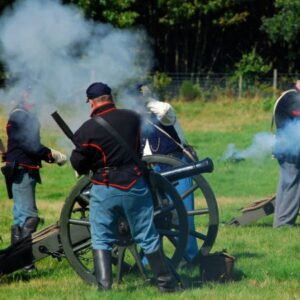
7. Teach Perspective
Often, it is difficult to recognize varying perspectives in our own lives. As so many people have “their truths” that they live by, understanding reality can be hard.
One fantastic element of An Occurrence at Owl Bridge is the concept of perspective. For much of the story, we actually only experience the protagonist’s dream, his delusion.
It seems real until it is, well, not. In fact, his reality is terrifying and quite sad, but his deluded moments offer him hope. And sometimes, we need hope, even if what we are hoping for is impossible.
If you are choosing to teach this story, take your time to explore reality versus dream!
Eager for ideas to teach literature? CLICK HERE!
8. Teach Questioning
Usually, we read a short story, teach a couple of standards, provide students with several assignments, and move on….we only have so much time, right?
Well, if you have time, I would encourage you to get your students to participate in a discussion involving this short story.
First, model how to base a question on a piece of evidence; annotating the story as you go along will certainly help! Then, provide a focus for each question (i.e. tone, mood, setting, theme, meaning, words/phrases, structure, tension, characterization, etc.). Lastly, give question stems to help students through the questioning process.
The following question stems might help facilitate discussion in a Socratic Seminar:
- How would you describe…?
- What character is…?
- What message do you think…?
- What character traits…?
- How does point of view…?
- What perspective does the author…?
- How does the author begin…?
- What is the tone…?
By posing and discussing such questions, we get students thinking, connecting, and analyzing beyond the text! That is definitely the ultimate goal!
If you need an easy-to-use READING TEST PREP QUIZ for An Occurrence at Owl Bridge, go HERE!
Why Teach An Occurrence at Owl Bridge (also known as An Occurrence at Owl Creek Bridge)?
- Increased Engagement-Students will definitely enjoy this harrowing tale! Will our hero escape? What’s really happening and why?
- Challenging Language-The text is difficult to understand, so it will challenge your students’ comprehension skills and vocabulary knowledge!
- Historical Connection-The story An Occurrence at Owl Bridge takes place during the American Civil War from 1861-1865, and it portrays a realistic version of a soldier’s experiences. Hopefully, students will make connections to what they are learning about in their United States History class!
Check out this BUNDLE below for print and teach activities for An Occurrence at Owl Bridge by Ambrose Bierce!
Need more help with teaching An Occurrence at Owl Bridge? Check out my store Kristin Menke-Integrated ELA Test Prep!

